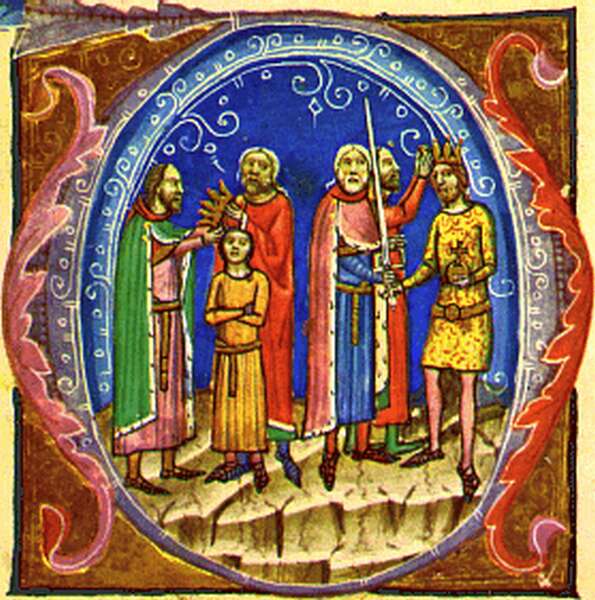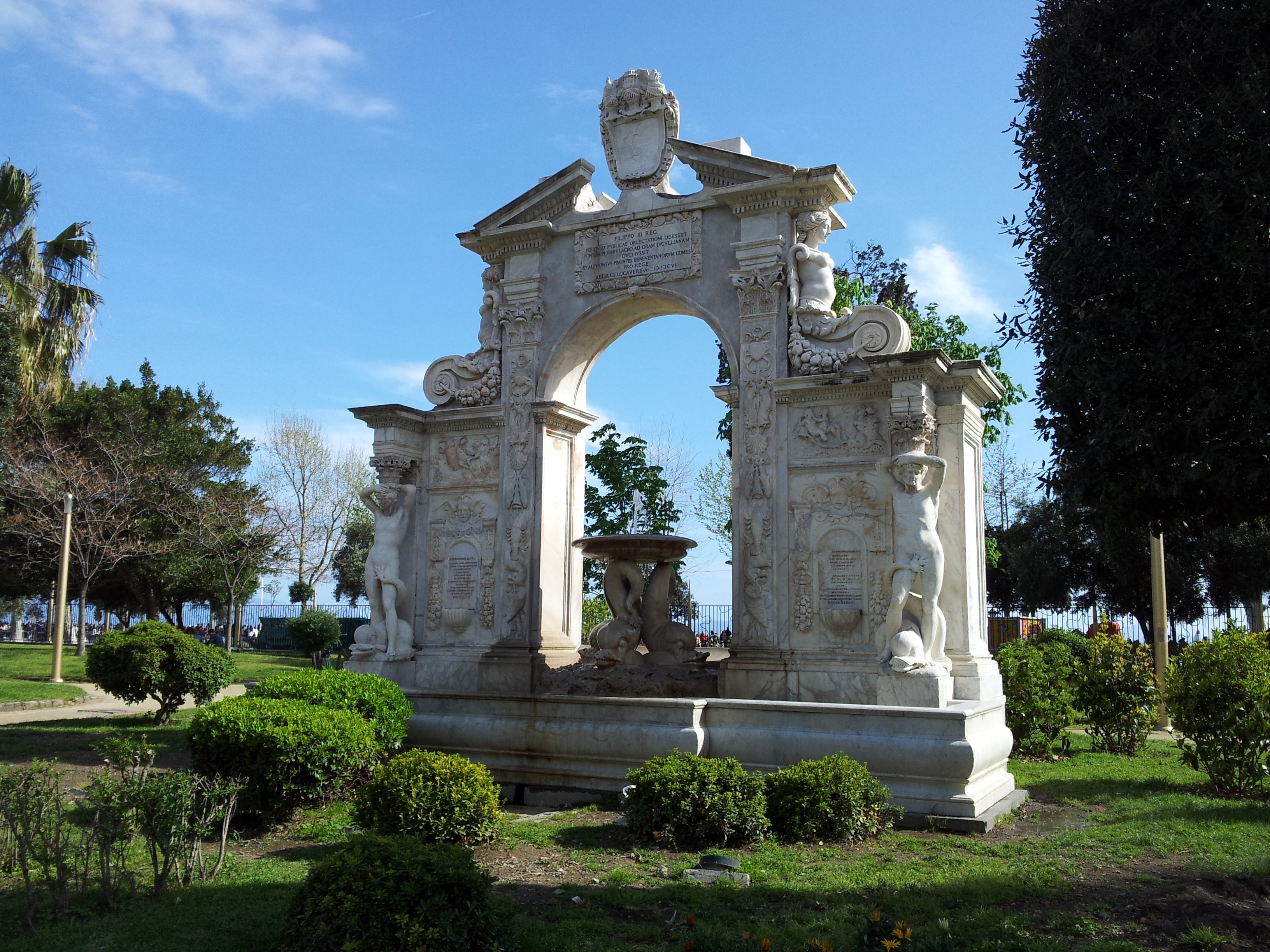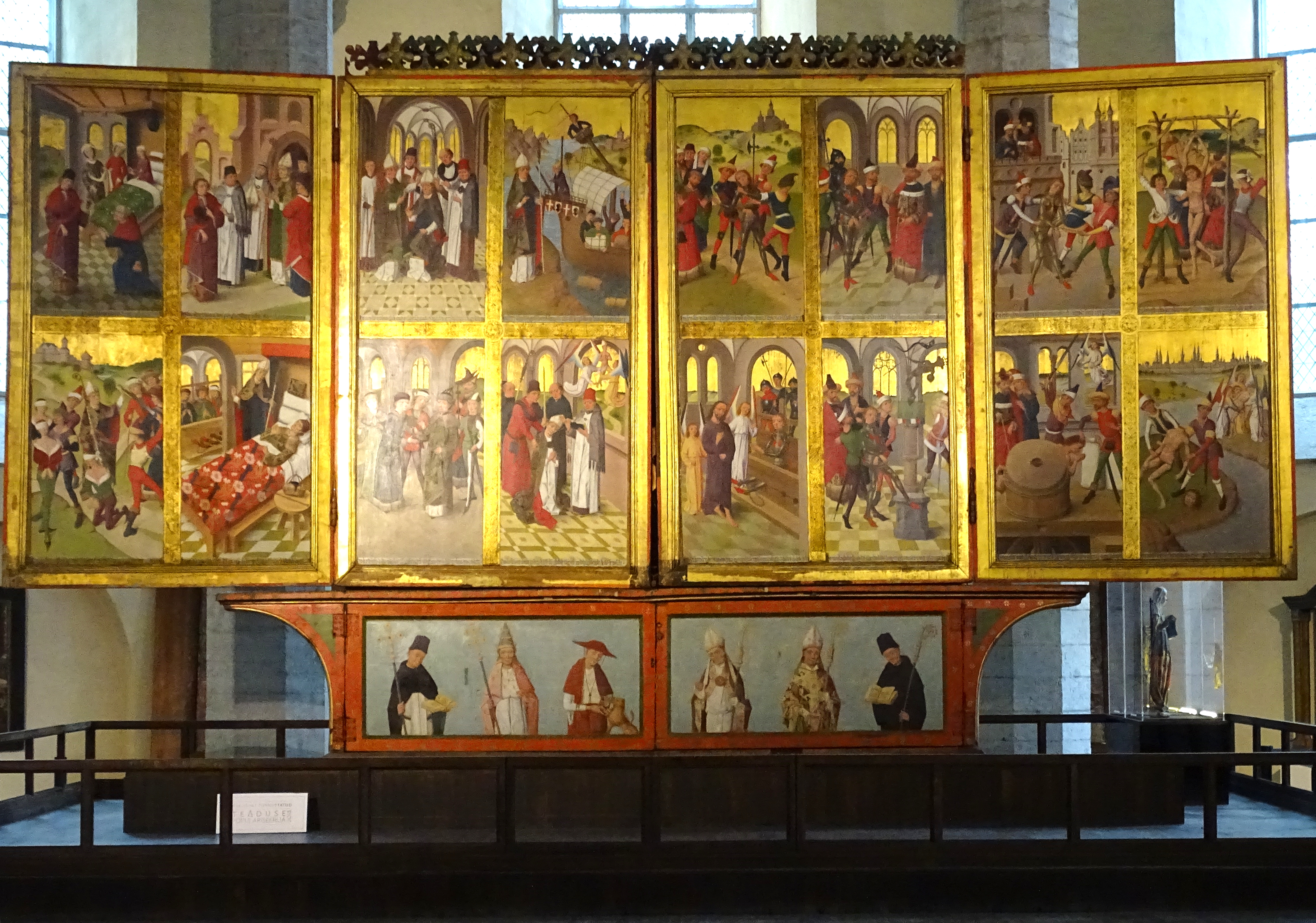|
Santa Maria Incoronata, Naples
Santa Maria dell'Incoronata is an ancient church on Via Medina in Naples, Italy. It is located just south of San Giorgio dei Genovesi and across the street from the Church of Pietà dei Turchini. The church was built in the 14th century in Gotico Angioiano style as part of urban project around the Castel Nuovo, the royal palace of Charles II of Anjou. The church was founded in 1364, not as tradition holds, in memory of the coronation of Joanna I of Naples and her second marriage to Louis, Prince of Taranto, but to hold a precious relic, a spine from the thorny crown of Christ, which the queen had requested from Charles V of France, and whose portrait is kept in the entrance. The edification of the Palace chapel or ''cappella palatina'' outside of the Castle, was completed in a difficult moment for the Queen, after the death of her husband in 1362. In 1403 Ladislaus of Naples ordered the painting of a cycle of Saint Ladislaus' legend in the church (finished 1414). There the Hun ... [...More Info...] [...Related Items...] OR: [Wikipedia] [Google] [Baidu] |
Naples
Naples (; it, Napoli ; nap, Napule ), from grc, Νεάπολις, Neápolis, lit=new city. is the regional capital of Campania and the third-largest city of Italy, after Rome and Milan, with a population of 909,048 within the city's administrative limits as of 2022. Its province-level municipality is the third-most populous metropolitan city in Italy with a population of 3,115,320 residents, and its metropolitan area stretches beyond the boundaries of the city wall for approximately 20 miles. Founded by Greeks in the first millennium BC, Naples is one of the oldest continuously inhabited urban areas in the world. In the eighth century BC, a colony known as Parthenope ( grc, Παρθενόπη) was established on the Pizzofalcone hill. In the sixth century BC, it was refounded as Neápolis. The city was an important part of Magna Graecia, played a major role in the merging of Greek and Roman society, and was a significant cultural centre under the Romans. Naples served a ... [...More Info...] [...Related Items...] OR: [Wikipedia] [Google] [Baidu] |
Saint Ladislaus
Ladislaus I ( hu, László, hr, Ladislav, sk, Ladislav, pl, Władysław; 1040 – 29 July 1095), also known as Saint Ladislas, was King of Hungary from 1077 and King of Croatia from 1091. He was the second son of King Béla I of Hungary and Richeza of Poland, Queen of Hungary, Richeza (or Adelaide) of Poland. After Béla's death in 1063, Ladislaus and his elder brother, Géza I of Hungary, Géza, acknowledged their cousin Solomon of Hungary, Solomon as the lawful king in exchange for receiving their father's former Duchy (Kingdom of Hungary), duchy, which included one-third of the kingdom. They cooperated with Solomon for the next decade. Ladislaus's Saint Ladislaus legend, most popular legend, which narrates his fight with a "Cuman" (a Turkic peoples, Turkic nomad marauder) who abducted a Hungarian girl, is connected to this period. The brothers' relationship with Solomon deteriorated in the early 1070s, and they rebelled against him. Géza was proclaimed king in 1074, but So ... [...More Info...] [...Related Items...] OR: [Wikipedia] [Google] [Baidu] |
Gothic Architecture In Naples
Gothic or Gothics may refer to: People and languages *Goths or Gothic people, the ethnonym of a group of East Germanic tribes **Gothic language, an extinct East Germanic language spoken by the Goths **Crimean Gothic, the Gothic language spoken by the Crimean Goths, also extinct **Gothic alphabet, one of the alphabets used to write the Gothic language **Gothic (Unicode block), a collection of Unicode characters of the Gothic alphabet Art and architecture *Gothic art, a Medieval art movement *Gothic architecture *Gothic Revival architecture (Neo-Gothic) **Carpenter Gothic **Collegiate Gothic **High Victorian Gothic Romanticism *Gothic fiction or Gothic Romanticism, a literary genre Entertainment * ''Gothic'' (film), a 1986 film by Ken Russell * ''Gothic'' (series), a video game series originally developed by Piranha Bytes Game Studios ** ''Gothic'' (video game), a 2001 video game developed by Piranha Bytes Game Studios Modern culture and lifestyle *Goth subculture, a music-cultu ... [...More Info...] [...Related Items...] OR: [Wikipedia] [Google] [Baidu] |
Churches In Naples
Christianity and religion in general has always been an important part of the social and cultural life of Naples. It is the seat of the Archdiocese of Naples, and the Catholic faith is highly important to the people of Naples and there are hundreds of historic churches in the city (about five hundred, 1000 in total). The Cathedral of Naples is the most important place of worship in the city, each year on September 19 it hosts the ''Miracle of Saint Januarius'', the city's patron saint. In the miracle which thousands of Neapolitans flock to witness, the dried blood of Januarius is said to turn to liquid when brought close to relics said to be of his body: this is one of the most important traditions for Neapolitans. Churches and their styles The cathedral of San Gennaro (Saint Januarius), was built under the patronage of Charles of Anjou in 1272, on the site of the ancient Stefania cathedral of the 8th century, and completed in 1341, the work of Nicolò Pisano, Maglione, and ... [...More Info...] [...Related Items...] OR: [Wikipedia] [Google] [Baidu] |
Santa Maria Di Costantinopoli, Naples
The Church of Santa Maria di Costantinopoli is a 16th-century Roman Catholic church located on the street of the same name in Naples, Italy, and located a block north of the Academy of Fine Arts of Naples. History Its name is allied to the cult of St Mary of Constantinople, the icon image of the virgin attributed originally to St Luke, which rose to prominence in 1527-1528, during one of the frequent attacks of plague afflicting the city. During this time, an elderly woman experienced an apparition of the Virgin who pleaded for the construction of a church where her image stood on a wall. Legend holds the image that was discovered prevented further outbreaks of the plague in Naples. Construction began in 1575, and continued till completion in the first years of the 17th century under the intervention of the Dominican architect Giuseppe Nuvolo. The façade was completed in 1633. The design is generally conservative with a central linear nave and two aisles, each with five chapels ... [...More Info...] [...Related Items...] OR: [Wikipedia] [Google] [Baidu] |
Giovanni Da Nola
Giovanni da Nola (1478–1559), also known as Giovanni Merliano, was an Italian sculptor and architect of the Renaissance, active in Naples. He was born the son of a leather merchant, in Nola near Naples. Da Nola moved to Naples where he trained under Aniello del Fiore and Benedetto da Maiano. In his youth, he traveled to Rome where he was influenced by Michelangelo, and then returned to Naples where he spent the rest of his career as sculptor and architect. As an architect he built a number of palaces in Naples, including the Palazzo Giusso, now the home of the Naples Eastern University. Many of the statues he created in Naples were removed to Spain by the viceroys then in charge of the Kingdom of Naples on behalf of the Spanish crown. When the viceroy Ramón de Cardona died in Naples in 1522, da Nola built his tomb in Naples, but it was then transported piece by piece to Bellpuig where da Cardona was buried. It remains one of the main examples of Italian renaissance art in Cat ... [...More Info...] [...Related Items...] OR: [Wikipedia] [Google] [Baidu] |
Michelangelo Naccherino
Michelangelo Naccherino (Florence, March 6, 1550 – Naples, February, 1622) was an Italian sculptor and architect, active mainly in the Kingdom of Naples, Italy. He supposedly was a pupil of Giambologna in Florence, but due to disagreements moved to the Kingdom of Naples in 1573. From 1575-1577, he was active in Palermo, where he worked alongside Camillo Camilliani in the construction of the Fontana Pretoria, a project of Francesco Camilliani. Returning to Naples, he completed a number of Mannerist projects such as the tomb of Alfonso Sanchez (1588–89) in the Basilica of Santissima Annunziata Maggiore and a crucifix (1599) for the church of San Carlo all'Arena. He also completed a ''Madonna della Sanità'' for the church of Santa Maria della Sanità in the zone of Materdei, where he lived. In the early 1600s, he participated in a variety of projects, including the Fontana di Santa Lucia and the Fontana del Gigante (along with Pietro Bernini). In 1607, he su ... [...More Info...] [...Related Items...] OR: [Wikipedia] [Google] [Baidu] |
Museum Of Capodimonte
Museo di Capodimonte is an art museum located in the Palace of Capodimonte, a grand Bourbon palazzo in Naples, Italy. The museum is the prime repository of Neapolitan painting and decorative art, with several important works from other Italian schools of painting, and some important ancient Roman sculptures. It is one of the largest museums in Italy. The museum was inaugurated in 1957. History The vast collection at the museum traces its origins back to 1738. During that year King Charles VII of Naples and Sicily (later Charles III, king of Spain) decided to build a hunting lodge on the Capodimonte hill, but then decided that he would instead build a grand palace, partly because his existing residence, the Palace of Portici, was too small to accommodate his court, and partly because he needed somewhere to house the fabulous Farnese art collection which he had inherited from his mother, Elisabetta Farnese, last descendant of the sovereign ducal family of Parma. Over the yea ... [...More Info...] [...Related Items...] OR: [Wikipedia] [Google] [Baidu] |
Polyptych
A polyptych ( ; Greek: ''poly-'' "many" and ''ptychē'' "fold") is a painting (usually panel painting) which is divided into sections, or panels. Specifically, a "diptych" is a two-part work of art; a "triptych" is a three-part work; a tetraptych or quadriptych has four parts, and so on. Historically, polyptychs typically displayed one "central" or "main" panel that was usually the largest of the attachments; the other panels are called "side" panels, or "wings". Sometimes, as evident in the Ghent and Isenheim works (see below), the hinged panels can be varied in arrangement to show different "views" or "openings" in the piece. The upper panels often depict static scenes, while the lower register, the predella, often depict small narrative scenes. Polyptychs were most commonly created by early Renaissance painters, the majority of whom designed their works to be altarpieces in churches and cathedrals. The polyptych form of art was also quite popular among ukiyo-e printmakers ... [...More Info...] [...Related Items...] OR: [Wikipedia] [Google] [Baidu] |
Roberto Oderisi
The name Robert is an ancient Germanic given name, from Proto-Germanic "fame" and "bright" (''Hrōþiberhtaz''). Compare Old Dutch ''Robrecht'' and Old High German ''Hrodebert'' (a compound of '' Hruod'' ( non, Hróðr) "fame, glory, honour, praise, renown" and ''berht'' "bright, light, shining"). It is the second most frequently used given name of ancient Germanic origin. It is also in use as a surname. Another commonly used form of the name is Rupert. After becoming widely used in Continental Europe it entered England in its Old French form ''Robert'', where an Old English cognate form (''Hrēodbēorht'', ''Hrodberht'', ''Hrēodbēorð'', ''Hrœdbœrð'', ''Hrœdberð'', ''Hrōðberχtŕ'') had existed before the Norman Conquest. The feminine version is Roberta. The Italian, Portuguese, and Spanish form is Roberto. Robert is also a common name in many Germanic languages, including English, German, Dutch, Norwegian, Swedish, Scots, Danish, and Icelandic. It can be use ... [...More Info...] [...Related Items...] OR: [Wikipedia] [Google] [Baidu] |
Chiesa Di Santa Maria Incoronata (Napoli) 011
Chiesa (Italian, 'church') may refer to: People with the surname * Andrea Chiesa (born 1966), Swiss Formula One racer *Anthony della Chiesa (1394–1459), Italian Dominican friar * Bruno della Chiesa (born 1962), European linguist * Carlo Alberto Dalla Chiesa (1920-1982), Italian military leader *Deborah Chiesa (born 1996), Italian tennis player *Enrico Chiesa (born 1970), Italian footballer ** Federico Chiesa (born 1997), Italian footballer, son of Enrico Chiesa *Giacomo della Chiesa (1854-1922), Italian bishop, became Pope Benedict XV * Giulietto Chiesa (1940-2020), Italian journalist and politician * Giulio Chiesa (1928-2010), Italian pole vaulter *Gordon Chiesa, American basketball coach *Guido Chiesa (born 1959), Italian director and screenwriter *Jeffrey S. Chiesa (born 1965), U.S. Senator; American lawyer; former Attorney General of New Jersey * Laura Chiesa (born 1971), Italian fencer * Mario Chiesa (politician) (born c1938), Italian politician * Michael Chiesa (born 1987), ... [...More Info...] [...Related Items...] OR: [Wikipedia] [Google] [Baidu] |
Chiesa Di Santa Maria Incoronata (Napoli) 008
Chiesa (Italian, 'church') may refer to: People with the surname * Andrea Chiesa (born 1966), Swiss Formula One racer *Anthony della Chiesa (1394–1459), Italian Dominican friar * Bruno della Chiesa (born 1962), European linguist * Carlo Alberto Dalla Chiesa (1920-1982), Italian military leader *Deborah Chiesa (born 1996), Italian tennis player *Enrico Chiesa (born 1970), Italian footballer ** Federico Chiesa (born 1997), Italian footballer, son of Enrico Chiesa *Giacomo della Chiesa (1854-1922), Italian bishop, became Pope Benedict XV * Giulietto Chiesa (1940-2020), Italian journalist and politician * Giulio Chiesa (1928-2010), Italian pole vaulter *Gordon Chiesa, American basketball coach *Guido Chiesa (born 1959), Italian director and screenwriter *Jeffrey S. Chiesa (born 1965), U.S. Senator; American lawyer; former Attorney General of New Jersey * Laura Chiesa (born 1971), Italian fencer * Mario Chiesa (politician) (born c1938), Italian politician * Michael Chiesa (born 1987), ... [...More Info...] [...Related Items...] OR: [Wikipedia] [Google] [Baidu] |



